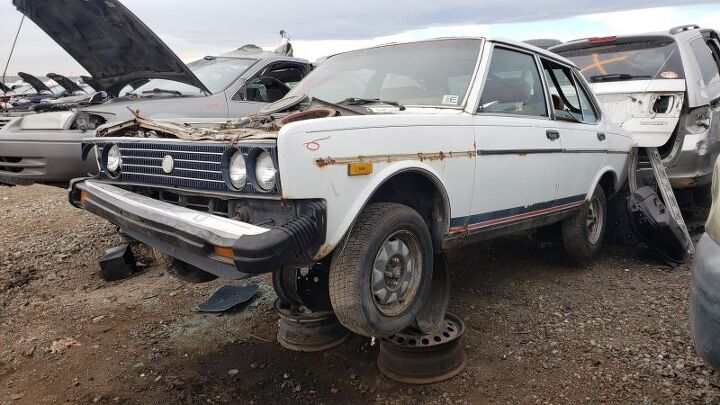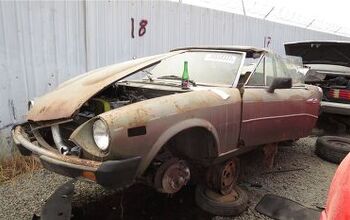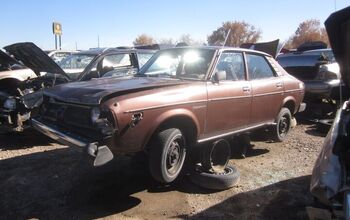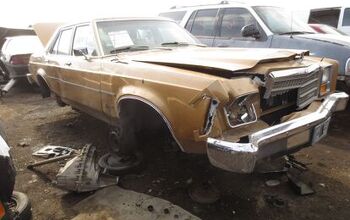Junkyard Find: 1979 Fiat Brava Sedan

While an ever-increasing number Americans in the second half of the 1970s felt comfortable buying sporty German and Japanese sedans, the idea of relying on an Italian sedan for everyday transportation made sense to a much more exclusive group. For those Americans who craved a commute packed with Italian passion and artistry but needed something with rear-wheel-drive (ruling out the 128 and the Lancia Beta sedan) and cheaper than the Alfa Romeo Sport Sedan, Fiat offered the 131 on these shores for the 1976 through 1981 model years (changing its name to the Brava starting in 1978). As you’d expect, these cars are about as tough to find in junkyards today as Mitsubishi Tredias or Rover 3500s, but I ran across this ’78 in a Denver yard last week.
This car has the 2.0-liter version of Fiat’s screamin’ Twin Cam four-cylinder, rated at 86 horsepower. Since the ’78 Brava scaled in at just 2,455 pounds, it wouldn’t have been agonizingly slow by the standards of the time.
A five-speed manual transmission was serious stuff in the late 1970s, though a three-speed automatic was available in the Brava.
The 120 mph speedometer seems optimistic. I might need to go back and buy that Quarzo clock for my hoard collection.
This vertical-loading glovebox and its sliding door demonstrates the sort of edgy Italian design your BMW and Audi drivers didn’t get in 1978.
The University of Northern Colorado parking sticker from 1993 indicates that this car was still on the road at the advanced age (for a Fiat in North America) of 15 years.
It’s a bit rusty, but it should have been possible to get this car back on the road. What happened? Usually, I can’t answer this question… but it happens that I know a bit about this car’s recent history.
A couple of years ago, the owner of a repair shop for Italian cars in Englewood, Colorado, passed away. Nearly 100 cars— mostly 1960s-1980s Fiats but also a sprinkling of Lancias and Alfa Romeos— accumulated in the shop’s storage yard went up for sale at bargain prices. I did my best to spread the word about all those Fiats in need of forever homes, but most of them ended up being hauled off for scrap value. In the photo above, you can see today’s Junkyard Find in the foreground.
Two years later, we can assume that whoever obtained this Brava tried without success to find a buyer to pay a few hundred for it and then made a sad call to U-Pull-&-Pay. I wish it had ended up seeking Class C glory on a 24 Hours of Lemons race track, but the local racers are full up with silly projects and trying to make room for more. Anyway, a car that began its career in a Denver Fiat dealership will end it in a Denver crusher. Circle of automotive life and all that, no?
This isn’t the first Aspen Motors auction car I’ve seen in a Denver-area boneyard lately, but it’s the first I’ve written about. Stay tuned for a future Junkyard Find, Junkyard Gem, or Junkyard Treasure featuring more sad Italian stories.
The Brava was priced very well for all its standard luxury features, with an MSRP of $4,995 (about $21,920 today) for the ’78 sedan with 2000 engine. A new BMW 320i cost nearly twice as much, at $9,315.
Fiat departed the United States in 1982, though Malcolm Bricklin continued to import 124 Sport Spiders and X1/9s with Pininfarina and Bertone badging fairly deep into the decade. Fiat returned to our shores nearly a decade ago, which means that once again it’s easy to find Italian subjects for this series.
For links to 2,100+ additional Junkyard Finds, visit the Junkyard Home of the Murilee Martin Lifestyle Brand™.

Murilee Martin is the pen name of Phil Greden, a writer who has lived in Minnesota, California, Georgia and (now) Colorado. He has toiled at copywriting, technical writing, junkmail writing, fiction writing and now automotive writing. He has owned many terrible vehicles and some good ones. He spends a great deal of time in self-service junkyards. These days, he writes for publications including Autoweek, Autoblog, Hagerty, The Truth About Cars and Capital One.
More by Murilee Martin
Latest Car Reviews
Read moreLatest Product Reviews
Read moreRecent Comments
- FreedMike If Dodge were smart - and I don't think they are - they'd spend their money refreshing and reworking the Durango (which I think is entering model year 3,221), versus going down the same "stuff 'em full of motor and give 'em cool new paint options" path. That's the approach they used with the Charger and Challenger, and both those models are dead. The Durango is still a strong product in a strong market; why not keep it fresher?
- Bill Wade I was driving a new Subaru a few weeks ago on I-10 near Tucson and it suddenly decided to slam on the brakes from a tumbleweed blowing across the highway. I just about had a heart attack while it nearly threw my mom through the windshield and dumped our grocery bags all over the place. It seems like a bad idea to me, the tech isn't ready.
- FreedMike I don't get the business case for these plug-in hybrid Jeep off roaders. They're a LOT more expensive (almost fourteen grand for the four-door Wrangler) and still get lousy MPG. They're certainly quick, but the last thing the Wrangler - one of the most obtuse-handling vehicles you can buy - needs is MOOOAAAARRRR POWER. In my neck of the woods, where off-road vehicles are big, the only 4Xe models I see of the wrangler wear fleet (rental) plates. What's the point? Wrangler sales have taken a massive plunge the last few years - why doesn't Jeep focus on affordability and value versus tech that only a very small part of its' buyer base would appreciate?
- Bill Wade I think about my dealer who was clueless about uConnect updates and still can't fix station presets disappearing and the manufacturers want me to trust them and their dealers to address any self driving concerns when they can't fix a simple radio?Right.
- FreedMike I don't think they work very well, so yeah...I'm afraid of them. And as many have pointed out, human drivers tend to be so bad that they are also worthy of being feared; that's true, but if that's the case, why add one more layer of bad drivers into the mix?





















































Comments
Join the conversation
I need to grab those doors for my Sbarro Windhound!
I had the 1980 version, with Bosch FI; ISTR FIAT claimed 100HP for it. The car was definitely fun to drive. But it seemed like driving it for a few weeks made the driver more impatient in traffic ("...Would all these slow morons ahead of me just *GET OUT OF MY WAY*!!!"). As my wife and I swapped cars over the years, whoever was driving the Brava was invariably more impatient. I owned several few FIATs over the years, and they were all mistreated by American mechanics. Every FIAT I bought used had several items mis-assembled (clutch cable linkage, thermostat, radiator supports, botched fan wiring...). After resolving those, plus a few old-age failures in the FI, my Brava became reliable, easy to start, as well as fun to drive. But it was always a challenge to find, diagnose, and fix the numerous botch-jobs scattered around the car. FIATs were infamous for their timing belts. Fortunately, the 2.0L engine in this car is a "non-interference" engine. The transmission was generally great. The pattern put Reverse below 5th gear, so an over-eager driver might select R when reaching for a (non-existent) 6th. FIAT fitted a clever gadget to the gearshift that locked out R when you were pulling the stick out of 5th. Very thoughtful. The 2.0L engine was a refinement of the venerable FIAT twincam, and had a relatively long stroke ("undersquare"). This improved low-speed torque, slightly, but the engine didn't rev very happily, and the sounds it made were more "moaning" than "exciting." FWIW, the twincams were legitimate "hemi-heads," although nobody seems to notice. These cars had super-heavy-duty bumpers, making them almost invulnerable in low-speed mishaps. Of course, those massive bumpers at each end of the car made it heavy, and reluctant to turn during spirited driving. The rear bumper of the Brava was *lower* than the front, for styling, and too low for US bumper standards; accordingly FIAT fitted taller rear springs, giving the car an unfortunate "nose-down" attitude. Rust was an issue for every FIAT of the 1970s-80s, but if you lived in a salt-free place (e.g. SF Bay Area), the rust grew relatively slowly. More annoying were the windshield seals; every FIAT I owned had windshield leaks. And FIATs of this vintage had pretty feeble wipers; not a great car in a rainstorm. My Brava had some kind of weakness in the front frame; it seemed like the front shock towers were tilting toward one another, giving the front wheels some un-fixable negative camber.